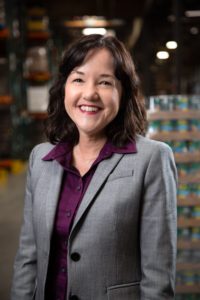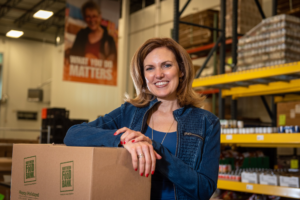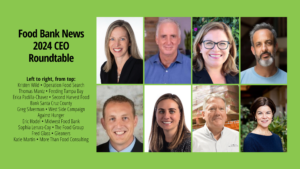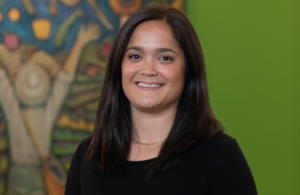The announcement last week that the USDA would continue to support food banks by purchasing massive amounts of produce, meat and dairy from the nation’s farmers was welcome relief to food bank CEOs, though they still expect a difficult 2021.
The $1.5 billion extension of the Farmers to Families Food Box program to a fifth round, announced Jan. 4, eased fears that a “food cliff” would surface as important government programs wound down at year’s end. The Covid relief package that just went into effect also helps by boosting the maximum benefit for SNAP by 15%, expanding some funding for school meals, and adding $400 million to the emergency fund for food banks.
Even so, a $2 billion program that provided food banks with goods from farmers suffering from the trade war with China has ended. And it’s unclear how the current level of aid will stack up against the unrelenting tide of need that is only expected to grow as unemployment benefits and stimulus checks eventually run out, back rents become due, and state resources likely run low.

Leslie Bacho, CEO of Second Harvest of Silicon Valley, cited these factors, as well as another round of stay-at-home orders stalling the California economy, as factors in her expectation that her food bank will continue to see a doubling of need into the foreseeable future. “We’re set up to continue to provide this level of service definitely through the next calendar year,” she said.
Government aid in all its forms has been critical to food banks’ ability to meet the unending demand for food during the pandemic. From May through November, for example, Greater Cleveland Food Bank distributed more than 300,000 boxes of food through the Farmers to Families program, compared to only about 100,000 boxes funded through private donations, said Kimberly LoVano, Director of Advocacy and Public Education. “It would be a huge gap to make up,” LoVano said of the Farmers to Families program.
Demand for food in the first place closely tracks the distribution of federal aid to individuals and families. About 3,600 people attended weekly drive-through food distributions hosted by Greater Cleveland Food Bank at the beginning of the pandemic, compared to less than half that in mid-May as unemployment and stimulus payments kicked in. As federal aid dwindled into the fall, attendance at the food distributions again soared, reaching about 5,000 families the week before Thanksgiving, LoVano said.

At Northern Illinois Food Bank, as much as 40% of the food distributed in 2020 came from government programs, compared to 9% to 11% typically, said Julie Yurko, President and CEO. The uncertainty of the food supply chain in 2021 is something the food bank has been planning against since mid-September, she added.
Northern Illinois aims to do all it can to increase the streams of donated food coming in, but also has a three-point plan to expand beyond donated food, including asking community partners like businesses and foundations to provide funds to help it purchase incremental food.
The food bank also plans to raise its profile throughout the region by emphasizing the convenience, dignity and anonymity of My Pantry Express, its online platform that lets clients order food online and pick it up at drive-through locations. Currently available at ten sites, the service will expand to 16 by the end of February.
Finally, Northern Illinois will “lean into SNAP,” Yurko said, by adding staff to its SNAP hotline and advertising it. The food bank is also working with retailers including Jewel-Osco and Walmart to promote SNAP in checkout lanes and on social media. “They’re in the same business as us,” Yurko noted of the retailers. “They want families to have enough nutritious food.”

Like Northern Illinois, River Bend Food Bank in Iowa is seeking to maximize channels of donated and purchased food, according to Michael P. Miller, President and CEO. In general, River Bend has been diligent about balancing its immediate response against the need to sustain the response over time, given the general lack of control over what the government will do, he said.
Longer term, Miller would like to use hunger’s heightened visibility to get more Americans involved in addressing food waste. He noted that 20% of the landfill in Iowa is made up of food, and one-third of that is still in its original packaging. “Let’s use the new visibility we have to rally society” against semi-trucks of food getting thrown away, he said, adding that government programs and food rescue are both important remedies to food insecurity.
Food Bank of the Rockies is embracing flexibility as it looks to 2021. It has already put aside its fiscal year operating budget, which had planned for only six months of increased food distribution ending on Dec. 31st. And rather than maintain a narrow view of its role, it is seeking to be more expansive in how it meets the needs of the community. “We’ve changed everything from if to how,” said Erin Pulling, President and CEO.
In the pandemic’s super-charged environment, Food Bank of the Rockies dramatically scaled up its infrastructure, adding a new warehouse, an expanded cooler, additional vehicles and new staff including a night shift. “We didn’t think we could grow this much this fast,” Pulling noted.

The experience has caused leadership to be more open-minded about “what we can be,” Pulling said. The food bank, for example, has doubled the number of older adults receiving home deliveries, a service previously viewed as too challenging to provide on a large scale. “How can we take this opportunity of the crisis and change the future of how we operate as a food bank?” she asked.
While the extension of the Farmers to Families program, expected to run through April, softens the immediate threat of a “food cliff,” the impact of the pandemic is expected to be felt for a very long time. “Things are going to be rough, regardless of what the federal government does,” Pulling noted.
Had the pandemic not struck, food insecurity finally would have declined to levels last seen in 2008, indicating that a full ten years was required to shake off the impact of the recession, Miller of River Bend noted. “I hope it doesn’t take ten years to get out of this, but that’s the model,” he said.
In the meantime, Miller intends to spread a message of hope, not alarm, to people experiencing food insecurity. “To those going to the food pantry and those working there, it’s been the hardest year they ever had. We may be stressed at the food bank, but we’re not going to pass that stress on by telling our agencies to expect less food. We’ve chosen to figure out how not to distribute less food,” he said.
Like what you’re reading?
Support Food Bank News












